Topics
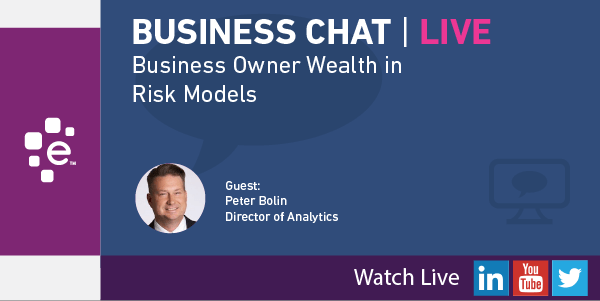
This week for Business Chat | Live we interviewed Peter Bolin about business owner wealth, and how lenders are finding new ways to evaluate entrepreneurs in the underwriting process. Gary: Today we're going to have a discussion on business owner wealth and evaluating business owner wealth in risk models. Joining me today is Mr. Peter Bolin. He's the Director of Analytics and Consulting for Experian. Good morning Peter. Peter: Good morning Gary. Good morning everyone. Gary: Let's just kick off this discussion. Business owner wealth and small business owners and evaluating risk. What's it all about? Peter: Yeah, thanks Gary, thanks everyone. As I travel around talking to a hundred clients a year, one theme that always comes back is, "Hey Pete, can you and Experian help us get to yes?" We know that there is a pool of small businesses, a pool of small business owners out there that are small, that are emerging, that are cutting edge, maybe not solid yet, but they don't have a credit file, what we typically call maybe credit invisibles or maybe thin files, but we know that they have a good idea, we know that they've good product and services, but we can't approve them. Is there anything you can do to help us get to yes? At Experian we got to thinking about that. We have a tremendous amount of data assets as everyone know. We looked around and we said, "Hey, there is this new product that we have called the Wealth Opportunity Score," and that estimates, based on our proprietary database, the wealth of an individual. We got to thinking, does wealth of a business owner affect the opportunity to be approved? That's what we're here to talk about today, Gary. Can we use the Wealth Opportunity Score on a business owner based on a sample of our data, we have some great results, and we definitely feel that we can help lenders, wholesalers, target marketers, get to yes. Gary: Okay. So you mentioned getting to yes. What does that mean in terms of say, a new business or a business that has say, a very thin credit file? How does that work? Peter: The first thing that we do when we're evaluating any new data source, and while wealth insights have been at Experian for a year or two, it's new, we're introducing it for the first time to the commercial space for the business owner, the first thing we do is say, "Okay, can we get a predictive lift by using this data?" The answer is yes. In particular, can we use this in the thin file, in the very, very small, emerging businesses that maybe we could refer to as the credit invisibles. It's kind of an overused term. Invisible to who? So, we're using this in this example as credit invisible are a very thin file or maybe have no file on the commercial credit report. We took a sample of business owners in that population and we added this Wealth Opportunity Score as an attribute within our demographic only segment, and we said, "Yes, indeed, this does help the predictive power of that segment." Going from a KS of a 16 to a 23. A KS for those of you who might not know, that's the Kolmogorov-Smirnov statistic, that's the industry standard for measuring the predictiveness of the model, the higher the KS the better the separation between the goods and the bad. We're seeing that yes, by just including this data, on the credit invisible/thin file, that segment was able to improve the predictive power by 43%. Gary: Wow, that's incredible. So, we discussed the better prediction of risk using the owner wealth. What does rank ordering have to do with that, and why is that such a big deal? Peter: As quant jocks sometimes we get overly, overemphasize the KS, the rock, the Genie, area under curve and those are all important statistics, but we can't forget about another critical part, which is the stability of the model. That's where we look at how well it rank orders. We'd like to see a nice, smooth monotonic progression in the rank ordering of the bads throughout the decile. We would like to see a large number of bads pushed down to the riskiest scoring, and fewer number of bads pushed up to the least risky. As you can see, when we added the Wealth Opportunity Score to our demographic only file, we got a nice, more smooth monotonic progression, which says not only do we get lift like we talked about in the first slide, but we're also improving the stability of the model, which is very, very important. As you can see, it's still a little bit choppy. Some of you might say, the skeptics out there might say, "Gee, Pete, this is all pretty choppy." However, keep in mind this is a demographic thin file, not much to go on other than some key demographic items, but by adding the Wealth Opportunity Score we're able to increase the predictiveness and the stability of the model. Gary: Wow. Okay, so there's been a lot of talk about women-owned businesses, minority-owned businesses lately. How does wealth play in the role in accessing credit for minorities, and in particular women-owned businesses? Peter: Absolutely. Gary, that's a huge topic right now, access to credit. Do minority-owned businesses and especially women-owned businesses have access to credit? We're also looking at data to help evaluate that. The next thing we did was, we were curious. Okay, is there a difference between a male-owned business and a female-owned business when it comes to wealth? Really, if you look at the bottom two lines on the curve, you see that there's really not. They're pretty similar. They are fairly similar. There is some blips on the lower side, so if you're looking at the left side of the graph, you do see where that pink line is the female owner, they do tend to have slightly lower wealth, and that's measured on the first Y axis. What we're saying is that there's really no difference. If you're looking at wealth, there isn't much difference between a woman-owned business and a male-owned business, so that should not be a prohibitor in access to credit. The other thing that we looked at on the other, secondary X axis, is the whole concept around annual spend. This is annual spend on the business owner personally, not the business, so I just want to make that clear. We looked at that, and we saw similar trends, that there really wasn't much difference in spending except in the very, very high quadrant up there, there was a little bit of difference in the extremely wealthy. Actually, it says that male owners, male business owners, had much more annual spend. So, not only were we introducing the Wealth Opportunity Score, which is a new concept in commercial lending, we're also looking at the total plastic spend on the business owner personally, which we found is a very powerful indicator, especially when you're trying to target market. Gary: Excellent. Okay, changing gears a little now, to target marketing and how does wealth help with those that are maybe in the market for credit? Peter: Well, it's very interesting Gary, because what we find is that there's an inverse relationship between wealth and in the market, so very, very wealthy owners are not as in the market based on our in the market score. We have a business credit seeker model, which predicts the likelihood that someone's going to open up a new trade, so, that they're in the market. They're really serious about it. We threw these attributes and this scores into that model, and what we found is that intuitively I think that it makes a lot of sense as well. What we see is that lower wealthy business owners are more in the market, right? They don't have any personal wealth. They need capital. They need access to capital. They're anxious to get capital. There's a higher percentage of the lower wealth spectrum that are looking for credit. However, however, that's not to say that the high end, so if you look at the very high end, three million or more in wealth, there's also a percentage, 9.5% of the population that are also looking for credit. They could be a small business, they could have two employees or less, they could be around for two years or less, but they have high net worth. They might be invisible on the commercial side and this Wealth Opportunity Score will definitely help them, help lenders and wholesalers get to yes. Gary: Are there other particular industries that you recommend targeting with the new business credit seeker model? Peter: Sure, that was the other kind of thing that was surprising to me, I'll be very frank. This surprised me, because when we looked at the industries and then we plotted the risk scores, and then we plotted the bad rates, and then we looked at the wealth of the individual, or sorry, not the wealth at this particular point. What we're looking at here is the actual in the market. What we found is that the industries that have the highest in the market percentage, which is measured on the blue bar, and then we look at their average IPV2 score, that's Experian's commercial risk score predict a likelihood of a trade going 91-plus, we see a convergence that the agricultural, wholesale trade and mining industry, which surprised the heck out of me, were the three industries that have the highest percentage and likelihood to be in the market, and also had the highest IP score, which means they have the lowest risk. The mining industry in particular, Gary, is shocking, because over the last eight years, without me getting too politically sensitive, that industry has taken a battering in the last nine years. Big cuts, big cutbacks, in traditional coal mining, and what we're seeing now, with some of the new administration's outlook on mining, the regulations are coming off and we're predicting that this could be a very big growth opportunity for our clients in terms of marketing, in terms of wholesale credit, traditional lines of credit, and traditional term-type credit. The mining industry in the market and a very high IPV2 score, and later on we'll see also some interesting wealth information about that as well. Gary: Excellent. You talked about credit scores. What about bad debt rates and industry targeting? Can you talk a little bit about that? Peter: Yep, very similar results. We also wanted to look and see what the bad rates were for each of these industries to give the viewers an opportunity to see this trend. This is also the exact same thing as you saw with the score, relatively low risk. Agricultural, wholesale trade, mining again, when you look at their bad rates as measured on that secondary axis, but high in the market. Very, very surprising to me, once again, I did not expect to see especially the mining, given the fact that they've been hammered the last nine months, so again, if you're looking about low-risk industries to target, those are the three that I would recommend. Gary: Does owner wealth matter in these industries in particular? Peter: It does, it does, especially again in the mining industry. You see some interesting wealth statistics. If you look at the distribution of the Wealth Opportunity Score, which once again, predicts the wealth of the business owner, or the individual but in this case we scored it with business owners, you see some blips. Those yellow bars, some blips, and as you can see, there's also a tremendous opportunity really up there in that big, look at up there, there's a significant percentage in all three of these industries, but particular mining industry that have extremely high net worth. We already know from previous slides that they have low risk, low bad rates, so again, the mining industry, high wealth, high scores, low bad rates, again, another indication that using this data can help you get to yes. Gary: What about micropreneurs, you know, these businesses that are just emerging, just getting started, they're credit invisible, right? Does the business owner wealth factor come into lending and risk models? Peter: Certainly, and the whole concept of a micropreneur, that's kind of a new term, I'm not even sure it is a word, but maybe we invented it, the micropreneur, a great concept, very, very small businesses. It's not uncommon, Gary, that I get the following statement made to me when I'm talking to clients: "Pete, we don't approve anyone that's been in business for two years or less. We don't approve anyone that has two employees or less. We don't approve anyone who's a sole proprietor. We want to avoid those type of businesses," and I would urge all of the listeners and all of the viewers to think a second time about that, because even if you look at the far right-hand side bar, there are 28% of the population with three million or more in estimated wealth, 28% of that population have been in business or have one or two employees or less. That wealth could be used in your personal guarantee situation, that could be used as collateral. The other nice thing about the Wealth Opportunity Score before I forget is actually evaluating the net worth of an individual. It gives you the opportunity to verify that. It's very common in these situations that if a small business, one or two employees or less, goes in for an application, applies and they have to have a personal guarantee, and they say, "I'm worth $3 million," well, how do you know? Well, with this system you can come to Experian and at least get an estimate that that wealth is right, that you've verified that wealth and that you can set your credit limits, you can set your approval accordingly. So again, what does it mean for the micropreneur? It means that if they have wealth, it's another data point that can help you. Gary: It's helping them get their businesses started. It's helping to drive the economy, which is, at the same time this is good for everybody. It's a win-win situation of, it sounds like to me anyway. Peter: Absolutely. You know Gary, the whole concept of what we're talking about today comes from my personal passion, and I know Experian Business Information Services as an entity's passion, to be an advocate for the small business owners. What we talk about frequently. Through this passion, we're looking at all of our data assets. Can we use our data assets for good? And the good is, as small businesses goes, so goes the United States, and I'm really passionate, and I know Experian Business Information Services is passionate about turning over every leaf, every piece to data, that will fuel small business growth and fuel our economy. Gary: That's awesome. Okay, well this has been excellent Peter. I think if folks are interested in this, we just invite them to drop a comment on the video here if you find this on YouTube, or come to our website, experian.com/b2b. I'm sure we can connect you to Pete and his experts in business information if you want to talk about business owner wealth models. Pete I want to thank you so much for taking time out this morning to come on and talk to us about this topic. I really enjoyed our chat, and we'd love to have you back again in the future. Peter: Thank you Gary. I had a lot of fun. My first live TV spot. Gary: All right, thank you Pete. Have a good day, and- Peter: Thank you. Gary: And have a good day everybody. Thank you so much for coming to our live video. As I said, we're just wading into this. We'd love to have more of these live shows. If you've got ideas for live shows, if there's things about business information, things that would help you be more successful in business or evaluating risk, just send us a note on our YouTube channel. We'd be happy to consider that, and maybe put a show together. Maybe even invite you on as a guest. That's it for today, so thank you everyone and have a good day.

Over the past 10 years, some of America's most venerable industries have found themselves threatened -- if not put on virtual life support -- by aggressive Web-based "disrupters." Traditional hotels and motels now face stiff competition from AirBnB. Old school taxi companies are losing riders to fast and nimble ride-sharing services like Uber and Lyft. Blockbuster Video? Killed by Netflix, Hulu and Amazon Prime. The Yellow Pages? All but killed by Google. And anyone who's been following the brick-and-mortar retail industry knows that Amazon and its digital brethren are in the process of making retail department stores -- along with the shopping malls they anchor -- as quaint as hydrogen-filled balloons. So what's the next industry likely to find itself up-ended by digital disruptors? It may very well be debt collection. Granted, the words “Debt Collection” will sometimes send a shiver through your spine. But past-due accounts are a serious problem for the affected businesses. Not to mention being a drag on the economy as a whole. In an April 27, 2017 article in Forbes, contributing writer Robert J. Sczcerba offers the following statistics: At any given time, there is an estimated $12 trillion in outstanding consumer debt, with $672 billion of that debt being at some stage of delinquency. At least 7,000,000 small businesses in the U.S. have trouble collecting payments from customers. Of these 7,000,000 small businesses, 49% of them had to write off bad debt in the past year and 43% have customers who are more than 90 days late on payments. So, yes, the collection of outstanding debt is a big deal. Which is why the debt collection industry has to innovate. While many hotel chains, retail stores and transportation services have at least tried to keep pace with technological advances -- and customer expectations -- the debt collection industry has remained relatively unchanged for decades. As quoted in the same Forbes article, Christoph Bene, Managing Director at Brock Capital Group, describes it this way: "Fifty years ago, debt collections agencies relied on annoying phone calls and form letters sent through the mail to encourage people to pay their past due accounts. Today, with the ubiquitous use of smart phones, texting, e-mail and social media, the debt collection industry -- yep, you guessed it -- still mainly relies on annoying phone calls and form letters." Which is where Artificial Intelligence (AI) comes into play. AI has the potential to revolutionize debt collection by reaching out to debtors via the media they use, speaking to them in a language they understand, and developing customized solutions based on each person's individual circumstances. For example: The Medium is the Message. There is a growing cultural divide between generations. A business that tries to communicate with recent college graduates the same way they do with retired Baby Boomers isn't going to be in business for long. The choice of communications media -- be it email, text message, live phone call, printed letter -- depends largely on the character of the recipient. And when an agency is dealing with hundreds -- perhaps thousands -- of delinquent customers, it takes a very "smart" application to choose the channel best suited for each message. Context is King. You don't speak to an employer the same way you speak to a sibling -- or a police officer. Similarly, a collection agency can't use the same language when reaching out to a top-earning corporate executive as they do when trying to collect from a single mother of five who's holding down two jobs. With AI, companies will be able to communicate with the tone, vocabulary and incentives most likely to engage the individual recipient -- automatically. Staying Within the Lines. There are myriad state and federal regulations designed to prevent abuses by over-zealous debt collectors. Unfortunately, the industry remains notorious for its use of off-hour phone calls, intimidating language, and other aggressive techniques to try and pry money out of resistant hands. Using sophisticated rules engines, collections agencies can now make sure that they stay on the right side of the law while still disseminating strong, effective communications. Personalized Solutions. If there is one industry where "one size fits all" makes no sense, it's debt collection. Every situation is different. Every debtor has his/her unique set of challenges. Counselors, working one-on-one with customers, may be able to work out win-win payment solutions, but this takes time, talent, training, sensitivity, creativity and money. For many companies, it's just not worth the investment. AI can make this ideal a practical reality. A truly "smart" tool can analyze and weigh literally thousands of payment scenarios in a second, offering up a solution perfectly tailored to the customer's cash flow and competing obligations. Learn as You Earn. Perhaps the biggest selling point about Artificial Intelligence is that it is, well, intelligent. AI does not more than blindly follow a set of instructions. It learns. It adapts. It grows. It improves. Each failure is a lesson. Each success is an insight. As AI becomes increasingly common in the debt collection industry, expect its efficacy to improve by the month. That not only means more cash in the hands of the companies to which it is owed, but also happier, more satisfied customers. Companies such as Intellaegis with their masterQueue product, have been working to streamline the skip tracing space for the past six years taking a smarter BigData approach to vehicle recovery and debt collection. And Experian, always a leader in financial risk and credit management, recently released two advanced tools designed to help businesses improve their collections results. eResolve is the first self-service platform to help consumers negotiate and resolve past due obligations. PowerCurve Collections brings together data, decisions, and the collections workflow in a single, unified system. These are just the first steps in what promises to be a genuine revolution for business collections as artificial intelligence, Big Data analysis, and predictive analytics combine to create automated workflows that work to the benefit of the creditor and the debtor. Businesses will receive more of the money they're owed. Customers will have less debt to manage. And best of all, no more of those annoying dinner-time phone calls.
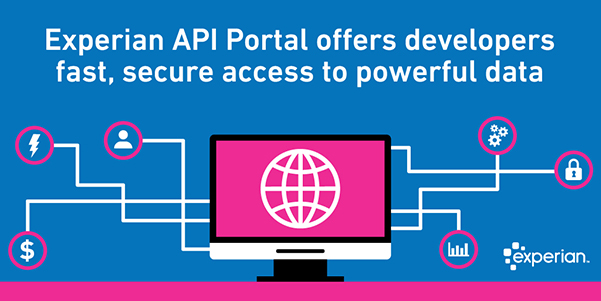
One of the world's largest financial institutions, Citi is determined to keep pace with rapid changes in international commerce. As detailed in the April 2017 issue of PYMNTS.com's B2B API Tracker Citi believes APIs – Application Programing Interfaces – are the key to getting international businesses the financial information they need to prosper. "We realized [our] clients were getting into newer business models which require faster access to payments [and] faster access to information," Mayank Mishra, managing director and global head of channel services for Citi treasury and trade solutions, told B2B API Tracker. "We had to go with a standard that was well-accepted by clients so they wouldn’t have to go through massive infrastructure changes." He noted the company's heavy investments in APIs will give its customers "the flexibility they're looking for to access the relevant information they want." Like Citi, Experian is eager to serve clients in a nimble, open fashion. To address this need Experian has created an API Developer Hub. Found at developer.experian.com, the Experian API Developer Hub is poised to expose the company's deep and detailed data on businesses and consumers, in addition to Experian’s automotive, health, and decisioning services in both the US and across the globe to the developer community. The API Bonanza Although they have been around for years, APIs have recently garnered lots of attention from companies of all types and sizes. "APIs are a technology exposed over the web that allow applications (software programs) to talk to one another," explained Mike Myers, Experian's Senior Director of Product Marketing. "APIs provide software developers with instructions on how to easily access and integrate data that can help fast track new ideas, partnerships, and innovation." Myers leads a team that creates business information APIs for the API Developer Hub, giving developers easy access to Experian's business information to use as they see fit. Laid out simply and intuitively, the Developer Hub serves as an easy-to-use "window" through which users can see: The depth and breadth of information Experian can provide to them How to acquire this information in a form most useful to their company How this information can be easily requested and consumed Serving Both Established Core Customers and Aggressive Start-Ups Myers explained that there are two principal markets for the new API Developer Hub: Mike Myers Experian AgileWorks "The first is our core customers, mainly financial institutions, insurance companies, trade credit, credit managers – basically the user who needs to integrate Experian data to determine their customers’ status, needs to reduce friction and minimize risk when making credit decisions as well as satisfy compliance regulations. This use case has been our bread and butter for decades," Myers said. "They need to manage risk. They must ensure their operations are in compliance. And, perhaps most importantly, when issuing credit, the likelihood that they’re going to get paid. That’s really the bottom line and is a key issue our API developer portal is designed to address." The second use case is designed for the developer community. “Developers are working for companies of all types and sizes that have yet to experience the power Experian’s data assets can deliver. They may share similar needs to our core users, but they most likely also have completely different market problems which Experian data can help solve. Maybe it’s a subset of our data applied to a new use case or maybe it’s combining our data with other data in new and innovative ways.” Experian designed the API Developer Hub to be as user-friendly as possible. New accounts can be setup in minutes. "It's taken a historically offline process and converted it to real-time” Myers said. Developers can explore a host of options, including access to APIs for Business Search, Business Credit, Commercial Public Records and Business Compliance Insight. We don't know what new apps or offerings will appear because of this new venture, but with the amount of energy, imagination and innovation driving today's tech world, we suspect that through APIs, developers will enhance the power of companies -- and consumers -- in ways we can't yet even imagine. We are proud -- and thrilled -- to be contributing to this ongoing revolution. Experian Developer Hub
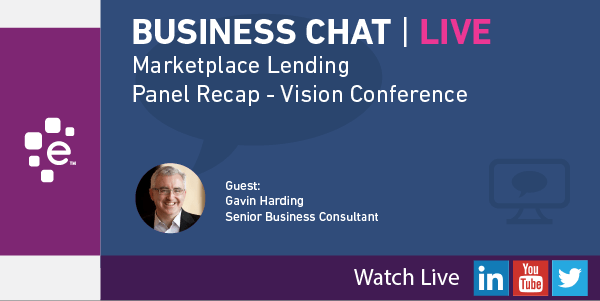
On May 9th we hosted an episode of Business Chat | Live on our YouTube channel and enjoyed an enlightening discussion with Gavin Harding, Senior Business Consultant with Experian Business Information Services. In our chat, Gavin shared highlights from his marketplace lending panel "Bridging The Gap: Reconnecting Investors with Marketplace Lenders in a Volatile World." Gary: We'll get started here. Welcome everybody. My name is Gary Stockton and I'm with Experian Business Information Services and we're gonna do a Business Chat Live today focusing on marketplace lending. I'm happy to be joined by Gavin Harding, and he's a senior business consultant with our business information services team on the global consulting side of the business. And Gavin is out at the Experian Vision Conference, so good morning, Gavin, or good afternoon, I should say. Gavin: Well, it's a little of both. It's morning for you and afternoon form me. Hi, Gary. Gary: So you had hosted a panel discussion yesterday called Bridging the Gap: Reconnecting Marketplace Investors with Marketplace Lenders in a Volatile World. Who was on the panel with you? Gavin: Well we had a really good industry cross section. We had Nat Hoopes who is the executive director of the Marketplace Lending Association. We had Frank Rotman who is the founding partner of QED Investors. And we had Peter Renton, who is the co-founder of LendIt, probably the biggest online marketplace lending conference worldwide. Gary: Peter Renton, he has worked on the LendIt Conference, but also Lend Academy, right? That's a resource for marketplace lending. I listen to his podcast. Gavin: That's right. Gary: We've spoken to Pete a number of times, so he's quite the expert in that field. There's been, in terms of marketplace lending and the news, there has been some negative news around the industry in recent past. Is that something that came up? Gavin: Indeed it did. Over the last 12 to 18 months, there has been a spate of negative publicity. The industry in general, the media has in a way turned on the industry on the basis of a couple of events related to specific companies in the space. The good news is that while that negative publicity had a negative impact last year, it seems that the industry has rebounded. It seems that it was a watershed moment where the industry recommitted to transparency, where they enhanced their whole approach to risk, improved their approach to operations. So if we characterize last year as perhaps a low point, the general theme of the panel was that the industry's really poised for growth, has grown up a lot over the last year. And you know, we talked a lot about credibility and trust and so on, and Nat, from the Marketplace Lending Association, you know, obviously that group started about a year ago and it has now grown to 19 members, so pretty rapid growth. When we think about the 19 members, we estimated that that covers about 90-95% of the total volume of loans and credit facilities in the space. So Nat and his team worked hard on transparency, disclosure, harmonizing standards and so forth, so it was really good to have him on the panel. Gary: And Experian, are we a member of the MLA? Gavin: We are a proud associate member, yes we are. Gary: Excellent. So let's talk a little bit about bank partnerships and what are the kinds of things you were talking about related to bank partnerships? I'm sure that was a big part of the discussion. Gavin: It was. About 24, 36 months ago is when this topic became pretty hot. Lots of conversation between banks and players in the industry. Those conversations in some very high profile ways result in partnerships. We think about Chase, we think about OnDeck. As the year has progressed, what's started to happen is, the mood within the industry has changed. Banks now expect partners in this space to speak their language in terms of risk, to be fully compliant, to understand all the rules and regulations. So the short statement is that in the last year, within the online lending space, compliance has become a competitive advantage. Compliance and operational discipline has become a selling point. So again, that's part of the ongoing theme of the industry and the sector growing up and maturing, so really positive. The one comment that I believe Frank had was as we think about partnerships with the banks, be prepared to hear no a lot before you get to yes. Be prepared to translate between the two very distinct audiences. So in terms of working with banks, use their language, understand the regulations, understand what pressures and demands are on them, and the outcome of that will be a much higher success rate and much more positive, productive conversations. Gary: Excellent. How about the sector performance overall? Is it a growing sector? The banks, I would imagine they've expressed a lot of interest in that. Are we seeing growth in that sector? Gavin: Interesting question. We talked about some of the negative publicity last year. Some of that related to some practices in parts of the industry over the last two to three years, so what's happening now is, because of a refocus and redirection towards credit risk management putting out more and better loans for appropriate returns and so forth, we're seeing the whole industry performance has really been elevated. A lot of the perhaps substandard loans or facilities have now run off, run off meaning they've matured and have been paid off. And the new business that's been put on is more sustainable. It's a more disciplined approach. So yes, overall the sector has improved significantly in terms of performance over the last year. Gary: Excellent. And so, obviously you're meeting with plenty of Experian clients there at the conference. What is this, your third or fourth Vision? Gavin: This is my third and we are here with, I think it's a little over 500 of Experian's clients globally. Many of clients from Europe, Asia, and so on so it's a really great experience. Gary: Yeah, and I saw you had Steve Wozniak, co-founder of Apple Computer as one of your keynote speakers. Gavin: That's right, that's right. On Monday morning for our breakfast presentation, we had the Woz and the big news on that, Gary, is, I know this will probably startle any listeners, that apparently Steve Jobs was not always a very nice person. So that's a newsflash there. Gary: Brilliant guy, though. You can tell I'm a customer. Gavin: Fantastic. The innovation, the dynamism was just radiating from him. He talked about some of his rules of life and he said he was never interested in money, he was interested in thinking and creating things and making things work. Somebody said, "Steve, what motivated you when you were an employee at Hewlett Packard and how does that maybe translate into what we should be doing with employees?" And Steve Wozniak said the major attraction for him at Hewlett Packard was that they let him go into their stores, their inventory, and take whatever electronic parts and components he wanted to create his own products at night. So he would talk about going home, having dinner, and going back, going into the stores, grabbing the components, and then making the products. And some of the original pre-Apple I computers were made from Hewlett Packard parts in Steve Wozniak's - he said didn't actually have a garage. It was more of a basement, but in his house. So really an interesting presentation. A really dynamic guy. We were lucky to have him. Gary: And you also had, an economic presentation by Diane Swonk I think I saw. Gavin: Diane Swonk this morning, really interesting presentation. A little bit of a different perspective than what we often see in terms of the high-level economic factors like just raw unemployment versus full employment and so on. She dug a little bit deeper but beyond that she had a couple of key messages. One of the messages is that we are almost at, depending on definition, full employment. Wages have increased over the historical averages over the last couple of years. So while the broad improvement in the economy was visible, it's only now hitting our pocketbooks. It's only now coming through in consumer spending. So that was pretty positive. She has worked a lot with both the current and past administration in terms of economic advisors and committees and so on, done a lot of work in Washington, DC. She is very much taking a wait-and-see cautious approach in terms of what the administration is saying. She confirmed that the intent or the goal investing heavily in infrastructure should have a dramatic effect on the economy overall, so she was supportive of that. The one question she had, and actually what she said was that her son on the way to school in the morning on the back of a napkin should be able to work out what the plan is to spend and at the same time reduce taxes without the other side of the equation is, to be charitable, going to require further definition. Gary: Wow, sounds like quite a conference. I'm quite envious that I'm not there to enjoy it with you this time, but maybe next time. Gavin, I really appreciate you taking time out. I know that there's a lot of people that you should be meeting with there, so I'm gonna go ahead and maybe end it right there for now. Maybe we can schedule another business chat soon. I know something's coming up with Moody's Analytics and yourself in June and the next release of the Main Street Report for Q1, so I'm excited to maybe talk about that in further detail with you very soon. Gavin: I look forward to it. Thank you very much, Gary. Gary: All right. Thank you very much. If you would like to be informed of new episodes of Business Chat | Live be sure to subscribe to our YouTube channel, and follow us on Twitter.
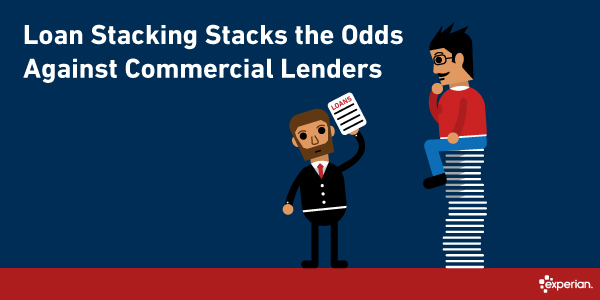
Loan stacking is a small but serious problem for Online Marketplace Lenders (OMLs). Often invisible to the issuers of commercial capital, businesses that engage in this insidious practice are significantly more likely to become delinquent on their payments and even default entirely on their obligations. If you manage a company that issues commercial credit, you need to be diligent in weeding out these bad players to protect not only yourself but your industry as a whole. What is Loan Stacking? Simply put, loan stacking is the opening of multiple credit lines within a short period of time. (Sometimes as little as 24 or 48 hours.) Because there is a natural lag in credit reporting, the lenders involved usually are unaware that other companies are transacting with the same customer. On the personal credit side, loan stacking is a potential problem for borrowers who run their multiple credit lines near – or up to – their maximums and then find they can no longer meet all of their monthly obligations. However, it’s not uncommon for individuals to carry multiple credit cards, and most credit card companies already have reliable systems in place to ensure borrowers don’t get more credit than their incomes justify. Things are different on the commercial side. Today, a lot of short-term borrowing occurs online through Merchant Cash Advances (MCAs). Repayment takes the form of weekly or even daily debits against the businesses’ cash receipts pulled directly from the borrower's checking account. For example, a restaurant may take out a $10,000 cash advance, the lender then taking five percent of that restaurant’s daily receipts until the advance is repaid – with interest. MCAs are not technically considered “loans,” and thus are not subject to the same regulations and oversight as traditional commercial lending. Such advances usually cover a period of four to eight months. Some can go as long as 12 months, but rarely do they go longer. MCAs are most popular among retail stores and have helped many small businesses get funding when needed. However, problems arise when a business takes out several cash advances at the same time. Instead of paying, say, 5 percent of daily receipts to a single lender, the restaurant loses perhaps 20 percent to four lenders simultaneously. At this rate, the business becomes unsustainable and defaults. Not only is commercial loan stacking a risky practice, it can be legally problematic. Many MCA providers are now placing anti-stacking language in their contracts that require borrowers to pledge not to promise their receipts to any other companies. Stacking loans violates this provision and thus may be tantamount to fraud. How common is commercial loan stacking? Based on our research and analysis, we believe that between five and six percent of all merchant cash advances are stacked. In 2013, the MCA market accounted for about $3 billion in transactions. By December 2016, that number had probably doubled. That means that between $150 million and $360 million in commercial loans are stacked. Granted, that's a drop in the bucket for the $1.9 trillion commercial lending industry, but for a small company just getting in the business of making such credit advances, it could be a serious threat to their portfolio's health. Why loan stacking occurs Why do MCA lenders allow themselves to be pitted against each other in this fashion? Blame the internet. The same internet that gives us the benefits of virtually instantaneous credit applications, reviews and approvals also makes it possible for businesses to easily make multiple applications within a 24- or 48-hour period. Many commercial credit reporting companies may provide updates as quick as 24 hours in some cases, a commercial MCA lender receiving a cash advance application may experience a slight delay in knowing if other lenders are working with the same customer. As for borrowers, most don't stack because they are not intending to commit fraud or otherwise game the system. They're doing so because, at the time, they believe they have no choice. Running a small business is difficult. Businesses often operate on thin margins and owners may, at times, struggle to make payroll. If there's a sudden setback or cash flow suddenly stalls, an owner may need a sizeable cash infusion just to keep the doors open. Being an optimistic lot, most owners who get multiple MCA loans do so in the belief they can quickly get over the hump, recover their losses, rapidly pay back what they owe and no one will be any the wiser. Sometimes, this strategy works. But too often, it does not. And that's when things get nasty. How to avoid loan stacking customers If you are an MCA lender and wish to avoid loan stacking customers, you have three tools at your disposal: Before making a cash advance, ask to see a full year of checking account activity. If you see a pattern of weekly or daily debits in a similar dollar range, this could be a sign that the business already has an MCA in place. If the business is relatively new, check their credit report for a high number of UCC (Uniform Commercial Code) filings. A large number of hard credit inquiries often indicates the owner is doing a lot of loan shopping, and this can indicate loan stacking. Sign up for Experian's custom short-term industry specific risk model consulting services. Signs of loan stacking, particularly in young companies with excessive UCC filings, can often be spotted using this service. For MCAs and all other forms of commercial lending to work, all parties have to play by the rules. Discouraging loan stacking not only benefits lenders, but also the borrowers who depend on the services these lenders provide.
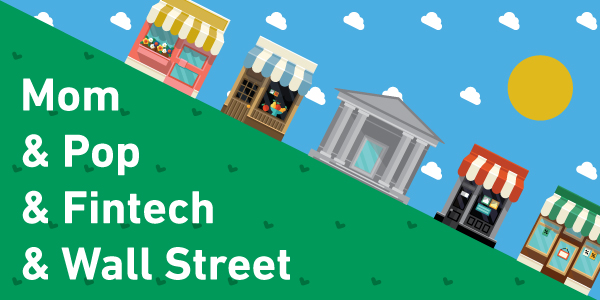
This year’s Marketplace Lending and Investing Conference explored issues of transparency, partnership, consistency and sustainability. There was healthy debate on each of these topics and the audience, presenters and panelists frequently returned to the theme of the relationship between Marketplace Lenders, Fintech, Banks and Investors. As the conference unfolded I thought about the role of small businesses in the relationship between these stakeholders. How do mom and pop small businesses fit into these complex, rapidly evolving relationships? In mid-2015 The Federal Reserve of Cleveland published a report. The title was “Alternative Lending Through The Eyes of ‘Mom & Pop’ Small-Business Owners: Findings from Online Focus Groups”. The report found that the small business owners participating in the online focus groups had a number of common concerns: Marketplace Lenders’ sites are attractive … but how secure? How private is the information the small business provides? It is difficult to compare product offerings, features and pricing The small business owners bank is a source of advice but is not necessarily considered as an option for funding There are some clear parallels with the conference’s focus on transparency, partnership and sustainability. See if any of these sound familiar: Regulators at the federal and state level are researching the Marketplace Lending industry and exploring ways and means of regulating the space. They are particularly focusing on issues of disclosure, fairness, privacy and governance. The CFPB – Consumer Financial Protection Bureau has been particularly active. There are two recent examples that illustrate increasing protection for small businesses. Dwolla was hit with a $100,000 fine in March of 2016, directly related to data security practices. Then, in late September LendUp was fined $3.5 million for deceiving its customers. The list of lenders who have strayed from fair and transparent business practices is long and growing. Fortunately, regulatory supervision of the online marketplace is here to stay. Banks largely abandoned the small business segment post 2008. Lack of profitability is most often cited as the reason for the exodus. Marketplace Lenders entered the space, delivered a wide range of product offerings, high levels of responsiveness and a relatively painless customer experience. Now, eight years later, banks and Marketplace Lenders are partnering to make the most of their relative strengths – deep customer relationships and the capability to deliver exceptional customer choice and experience, through technology. Leaders in the various stakeholder organizations are still focused on surviving, meeting goals for growth, managing risk and optimizing returns. In the past these may have conflicted with the small business owners interests. In late 2016, they are in alignment … and that is good news for small business owners throughout the US economy. If you would like to hear more of what I learned at Marketplace Lending and Investing, check out the Live Marketplace Lending & Investing Q&A I recorded from the conference.
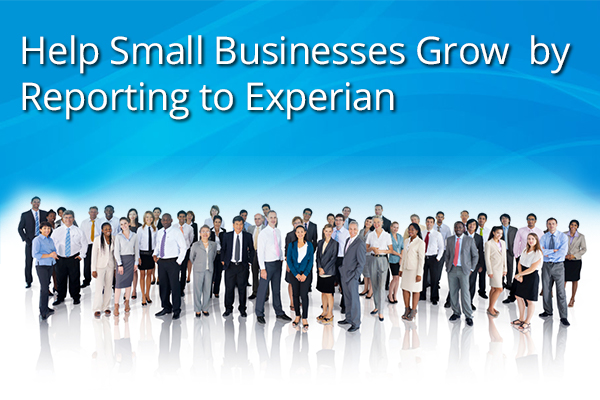
Reporting business data to Experian is an important and essential part of the credit ecosystem. Data provides a more complete credit history and in turn helps small businesses grow. Small businesses that have limited tradelines can sometimes face difficulty qualifying for loans and getting access to capital, so lenders and commercial trade partners who report data to Experian are giving small businesses the credit they deserve. How to report data to Experian You can start the process of reporting data to Experian by following a simple 8-step process outlined in this video. Our data acquisition specialists are standing by to help onboard new business data contributors and can answer questions to make it a seamless onboarding experience. You can also find more information on our data reporting page experian.com/datareportingbusiness. We have also created a handy Infographic which describes how to contribute both consumer and small business data. Get Started Reporting to Experian
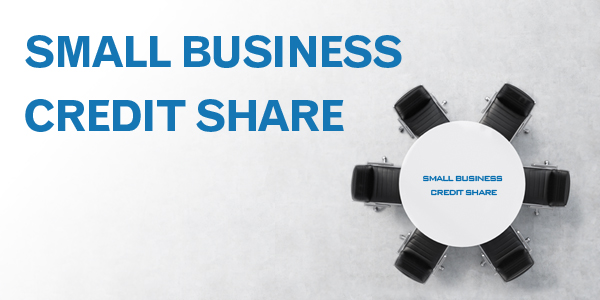
According to the U.S. Small Business Administration (SBA), small businesses account for 99.7 percent of U.S. employer firms and 64 percent of new private-sector jobs. So it stands to reason that the way small businesses go, the economy probably follows suit. One of the biggest challenges for small businesses, however, is the ability to access capital. In order for them to grow, they need money. Many of these smaller firms have limited to no credit history on file. For that reason, it is imperative for lenders and trade creditors to leverage comprehensive data sources (both financial and non-financial), enabling them to make smarter business decisions and help small businesses access credit. It is Experian’s core belief that an open and secure data sharing program is crucial to helping small businesses get the credit they deserve, and it's Small Business Credit Share® program is at the center of this ideal. Small Business Credit Share℠ is a Credit Data Sharing "Club" Small Business Credit Share℠ (SBCS) is a consortium of banks, credit card companies, leasing agencies and other companies that have agreed to provide financial and non-financial data in exchange for exclusive access to data from other contributors. By gaining access to this database, lenders and trade creditors can make more informed decisions, while also promoting financial inclusion and spurring growth within the small business segment. Currently, six of the nation's top ten financial institutions are members, as well as several telecommunications and utilities companies. Small Business Credit Share℠ offers more aggregates (data elements) than any other service of its type. Whereas many lenders rely primarily on summary data (e.g., a credit score and reports of missed payments over the past year), Small Business Credit Share reports include a vast array of detailed credit, financial and non-financial data. As a requirement of membership, members must contribute at least 10 pieces of data on each small business account, such as account types, highest credit utilized, total account balance and payment history profiles. Together, these aggregates provide a much deeper, more meaningful view of a small business than was ever possible when drawing from just a handful of sources. They have also proven to be a far more accurate predictor of credit risk than any other service Membership Provides Benefits to Financial Institutions and Borrowers Alike Small Business Credit Share℠ provides significant benefits to member institutions as well as to the customers they serve. For example, Small Business Credit Share allows members to see the obligations an applicant already has to other lenders. With this knowledge, a lender can make sure an applicant does not become overextended and thus jeopardize their ability to pay back the loans already outstanding. A lender can also generate reports that, when shared with a customer, help ensure that paying back that lender becomes a priority so as to strengthen their credit score. Small Business Credit Share can also help members achieve SBA compliance, as the SBA mandates reporting to "bureaus" for all SBA-backed loans (SOP 50 57). To Get More, Give More As in life, what you can get out of the Small Business Credit Share℠ tends to be directly proportional to what you put into it. The more data members share, the clearer the picture of their small business borrowers becomes, and the smarter credit decisions they are able to make. Watch our Small Business Credit Share Program Overview Video We're encouraged by the overwhelmingly positive reception the Small Business Credit Share has received from the financial industry as a whole and from our member companies in particular. We remain committed to the idea that financial inclusion provides a strong value proposition to the Financial Services community, and believe Small Business Credit Share aligns with that ideal. Small Business Credit Share
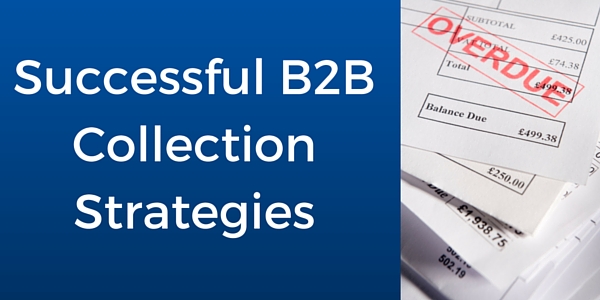
Businesses are faced with the need to collect on delinquent accounts. When pursuing these past-due accounts, the most successful way to approach them is with a combination of perseverance, politeness, and professionalism. This serves the dual purpose of increasing the likelihood of receiving a prompt payment and also staying within the guidelines set forth by the Fair Debt Collections Practices Act. Perseverance While constantly calling a customer for payment can be a drag, perseverance will pay off—literally. Keep notes when calling the customer, detailing when you called, the time you called and if the customer promised payment. If payment was promised, make a note of when. Most software will have note-taking capabilities, so use that to keep track of whether the customer is following through with payments or not. Aim to call once a week to keep your company in the forefront of the customer's payable person. Politeness Being polite can be trying when the customer is being evasive about payment status. Remember the old adage of catching more flies with honey than vinegar. Being polite gives the customer less reason to avoid payment. Share a story or joke with them. Get familiar with the person doing the payments for your business. Avoid negative outbursts containing vulgar language or calling multiple times per day, which are both violations of FDCPA code. Professional Above all, remain professional. Do not allow emotion or personal feelings about the customer cloud your attitude. This is strictly business, and the customer who may be slow or evading payment would do the same to anyone else in your position. Talk to them about payment plans if they are having a hard time paying. If they are hesitant to pay, ask for the reason why. Is there an issue with the product or service your company offers? If there is a problem with the product, talk to product/servicesupport staff to see if they are aware of this issue. If they are, ask them to contact the client with the solution. Sometimes it is necessary to involve sales representatives while collecting. The sales rep can go in and play "Good Cop," letting the customer know that they would love to sell them more product or further service, but that there's a problem with the account that needs to be resolved with the customer's accounts payable department. This normally results in the procurement associate contacting the accounts payable department and asking why payment has not been made on the prior purchase. Thisfacilitate payment, and in turn, increase company cash flow. Using these techniques will reflect respect and courtesy, which in turn elicits goodwill with the customer. Business Chat | LIVE - Credit & Collections with Katie Keitch We had a great interview about best practices in B2B Collection with Katie Keich. Katie is the V.P. of Commercial Services at InsideARM. She shares how to drive a successful collections strategy in your credit department or through 3rd party collections. Learn more about InsideARM
